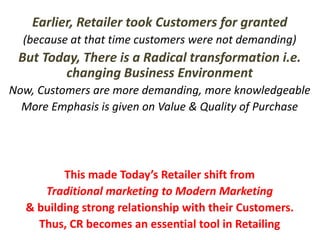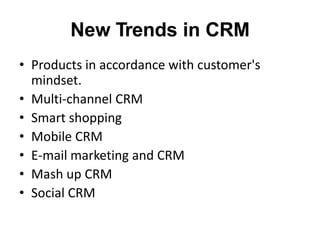Crm in retail industry
- 1. CRM In Retail Industry Presented by: Pooja Choudhry (43-2016) Radhika Gandotra (45-2016) Vidhu Arora (65-2016)
- 2. Earlier, Retailer took Customers for granted (because at that time customers were not demanding) But Today, There is a Radical transformation i.e. changing Business Environment Now, Customers are more demanding, more knowledgeable More Emphasis is given on Value & Quality of Purchase This made Today’s Retailer shift from Traditional marketing to Modern Marketing & building strong relationship with their Customers. Thus, CR becomes an essential tool in Retailing
- 3. Introduction to CRM • Customer relationship management (CRM) is a comprehensive strategy to manage a company's interaction with current and potential customers. • It aims to establish long lasting and mutual relationship with customers which will increase Customer value and optimize profitability • Various CRM programs have been developed which can contribute an economic value to the company and gives Competitive Advantage to improve customer services.
- 4. CRM Software Revenue (millions of US dollars) CRM Market Revenue reached $27.5 B in 2015, up from $23.8 B in 2014 , $36.5 B in 2017. The analyst forecast the CRM market reaching $46.4 B by 2019 So, Each year there is an increment in the CRM Software Revenue Forecast
- 5. Aspects for CRM 1. CUSTOMER SATISFACTION 2. CUSTOMER RETENTION 3. CUSTOMER LOYALTY 4. CUSTOMER COMPILE INFORMATION
- 6. Necessity of CRM in Retailing • To know their customer’s needs & wants in a customize way _ • By continuously maintaining communication with customer, retailer can know their changing demands & can bring innovative products. • To record Customer purchases • To deliver the desired products quickly in the hands of their customer _ • Gives Information regarding P/S or discount being offered. • By applying CRM , a retailer can know there most profitable and less profitable customer_ Retailer use CRM concept to the following reasons:
- 7. HOW RETAILER BENEFITED BY CRM • If there is a strong relationship between a retailer and a customer then Retailer generates no. of benefits by CRM: 1. Generate Maximum Sales -by repetitive purchase of Loyal customer 2. Greater sales ensures Maximum profit level 3. By applying CRM concept , Retailer can ensure Customer Satisfaction which lead to + WOM_ 4. Cross selling- (Technique in which Retailer suggest additional P/S to loyal customers during a buying process to increase revenue) 5. By using CRM ,Retailer can protect customer in competition i.e. Loyal customer stay close to retailer even if they don’t get appropriate P/S
- 8. In order to satisfy a customer and retain them for longer period of time, 1. Person-to-Person experience 2. Store experience 3. Marketing and communication 4. Price and value Top satisfaction drivers for building strong relationships
- 9. Process of CRM in Retail • CRM is an iterative process that turns customer data into customer loyalty through different type of activities. Levy and Weitz described CRM in retailing through a systematic process -
- 10. Collecting Customer Data – by constructing a customer database or Customer data warehouse • Customer Database Histories of purchases Customer contact Customer preferences • Approaches for collecting Information Asking for information Using frequent shopper card and credit card information
- 11. Analyzing Customer Data & Identifying customer Targets– by analyzing customer database &using the information retailers develop programs for building customer loyalty • Techniques to analyze Customer- Data Mining Market basket analysis Identifying market segments Identifying best customers – Lifetime value Customer Pyramid Approach RFM analysis( Recency, Frequency, Monetary)
- 12. Developing CRM programs • Retaining the best customer (Customer retention) Providing incentives or discounts Special customer service Personalization Informal communication • Converting good customers into best customers Cross selling Add-on selling • Dealing with unprofitable customer
- 13. Implementing CRM programs • Stage 1 – Collecting information • Stage 2 – Storing information • Stage 3 – Accessing information • Stage 4 – Analyzing consumer behavior • Stage 5 – Marketing more effectively • Stage 6 – Enhancing the customer experience
- 14. Reasons for CRM implementation failure in Retailing • Customer Focus • Weak management • CRM Project Management • Team members • Data & Warehouse Requirements
- 15. Suggestions for successful CRM implementation in Retailing • More emphasis on customer satisfaction • More use of IT to collect information timely • Retailer should be flexible to bend its rules & procedures in the customer favor • Retailer need to focus on informal relationships & communications with customers • Retailer must know the drivers for customer satisfaction and dissatisfaction • Retailers need to develop training programs to understand CRM process and serve customers better
- 17. New Trends in CRM • Products in accordance with customer's mindset. • Multi-channel CRM • Smart shopping • Mobile CRM • E-mail marketing and CRM • Mash up CRM • Social CRM
- 19. Mobile CRM
- 20. What s Good about Email Marketing •Highly targeted • Immediate •Measurable •Reach •Cost Effective Email Marketing and CRM
- 21. Mash‐ups to CRM A mash‐up is a web application that combines data from more than one source into a single integrated view. Content used in mash‐ups is typically sourced from a third party via a Widget or API (web service). Minimized application data management Reduced development effort Make CRM SMARTER
- 22. Social CRM
- 23. Need of CRM •Changes in the Business Environment •Customers becoming more demanding •Markets are saturated •Databases today are huge: •More than 1,000,000 entities/records/rows •From 10 to 10,000 fields/attributes/variables •Gigabytes and terabytes •Databases are growing at an unprecedented rate •Decisions must be made rapidly and with maximum knowledge •Extremely large datasets •Useful knowledge that can improve processes •Sophisticated data search capability that uses statistical algorithms to discover patterns and correlations in data.
- 24. Pre CRM vs Post CRM
- 25. Conclusion • CRM today has become the synonym to success in business. The retailers can effectively achieve it, if they identify the opportunities to enhance customer value. • Retailers can personally create programs and develop products for each individual customer. • In order, to create a healthy Customer-Retailer bond, customer satisfaction and loyalty will lead to customer lifetime value and retention in the long-term relationship with each other. • Thus, both will have a profitable and sustainable achievement at the end of the day.

























